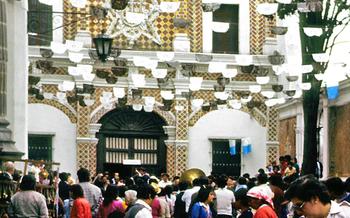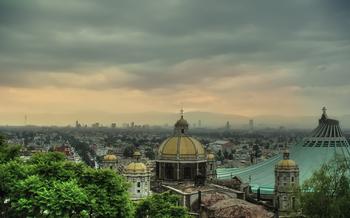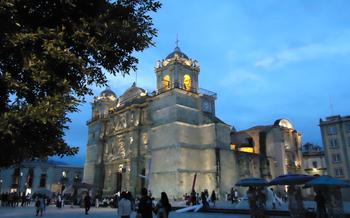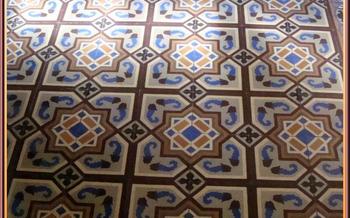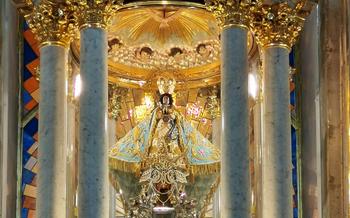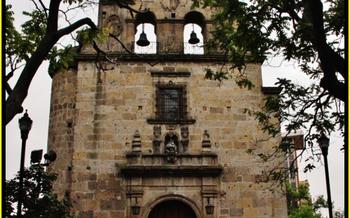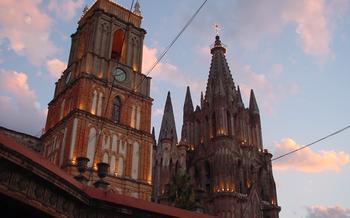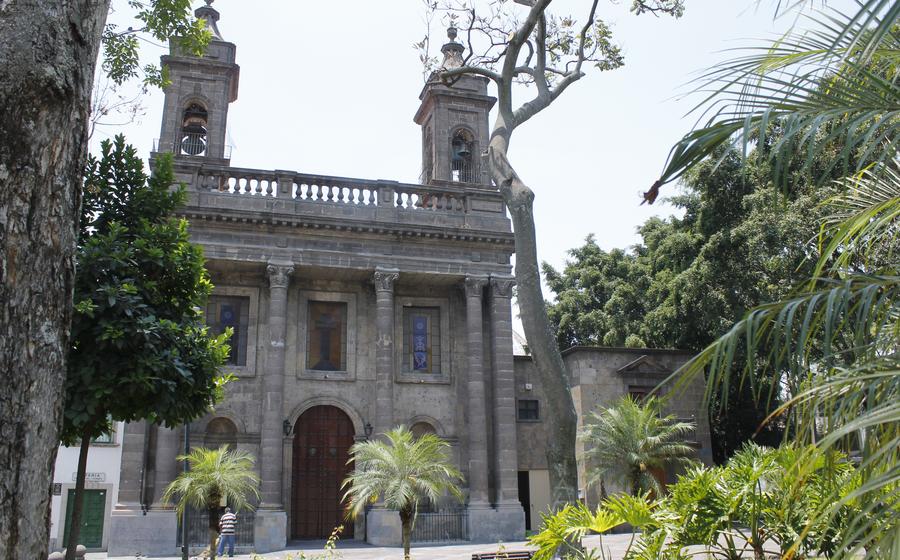
Templo de Nuestra Señora del Carmen
- Templo de Nuestra Señora del Carmen: An Architectural Masterpiece
- Intricate Details of the Facade
- Exploring the Templo's Interior
- The Altar of Our Lady of Carmen
- Visiting the Temple for Religious Services
- Templo's Role in Local Celebrations
- Architectural Techniques and Craftsmanship
- The Temple's Cultural Influence
- Exploring the Surrounding Plaza: Plaza de los Mariachis
- Combining History and Entertainment
- Templo's Connection to the City's Identity
- Templo de Nuestra Señora del Carmen: A Must-See Destination
- Insider Tip: Experiencing the Temple at Night
Templo de Nuestra Señora del Carmen: An Architectural Masterpiece
The Templo de Nuestra Señora del Carmen stands as a testament to the architectural prowess and cultural heritage of Guadalajara. Built in the 17th century, the temple showcases a harmonious blend of Baroque and Neoclassical styles, reflecting the transition between artistic eras. Its elaborate facade, intricate interior design, and significant religious symbolism make it a must-visit destination for history buffs, architecture enthusiasts, and pilgrims alike.
The temple's historical significance is deeply intertwined with the city's development. Founded by the Carmelite Order, it played a pivotal role in the religious and social life of the community. Its construction spanned several decades, with contributions from renowned architects and artisans who infused the temple with their unique artistic vision.
The architectural style of the Templo de Nuestra Señora del Carmen is a captivating fusion of Baroque and Neoclassical elements. The exuberant ornamentation, curved lines, and dramatic contrasts characteristic of the Baroque style blend seamlessly with the Neoclassical emphasis on symmetry, restraint, and classical motifs. This fusion creates a visually stunning edifice that commands attention and admiration.
Intricate Details of the Facade
The facade of the Templo de Nuestra Señora del Carmen showcases a harmonious blend of Baroque and Neoclassical influences, creating a visually captivating spectacle. Elaborate sculptural elements adorn the facade, each telling a unique story. Angels, saints, and various religious figures grace the niches and cornices, their intricate details adding a touch of divinity to the temple's exterior.
Symbolic motifs abound on the facade, each holding profound meaning. The central pediment features a magnificent relief depicting the Assumption of the Virgin Mary, a testament to the temple's dedication to Our Lady of Carmen. The integration of the temple's facade with its urban surroundings is a sight to behold. The temple seamlessly blends into the vibrant Plaza de los Mariachis, creating a cohesive and harmonious environment that invites visitors to immerse themselves in the rich cultural tapestry of Guadalajara.
Exploring the Templo's Interior
The interior of the Templo de Nuestra Señora del Carmen is a testament to the skill and artistry of the craftsmen who built it. The layout of the temple follows a traditional basilical plan, with a central nave flanked by two aisles. The nave is separated from the aisles by rows of massive columns, which support a series of arches that rise to a barrel-vaulted ceiling.
The walls of the temple are adorned with a variety of religious artifacts, including paintings, sculptures, and stained-glass windows. The main altar is a particularly impressive sight, with its elaborate carvings and gold leaf decoration. The altar is home to a statue of Our Lady of Carmen, the patron saint of the temple.
The murals and paintings that decorate the walls of the temple are a testament to the skill of the local artists who created them. The murals depict scenes from the life of Jesus Christ and the Virgin Mary, as well as from the history of the Catholic Church in Mexico. The paintings are in a variety of styles, from Renaissance to Baroque, and showcase the diversity of artistic influences that have shaped Mexican art.
The stained-glass windows of the temple are another highlight of the interior. The windows depict scenes from the Bible, as well as from the lives of the saints. The colors of the windows are vibrant and rich, and they cast a beautiful light into the interior of the temple.
The Altar of Our Lady of Carmen
The focal point of the Templo de Nuestra Señora del Carmen is its stunning altar dedicated to Our Lady of Carmen. This elaborate structure is a masterpiece of Baroque and Neoclassical art, showcasing intricate carvings, delicate ornamentation, and vibrant colors. The altar serves as a shrine to the beloved patron saint of Guadalajara, attracting devotees from all over the region.
The centerpiece of the altar is a beautiful statue of Our Lady of Carmen, adorned with intricate vestments and a radiant crown. The Virgin Mary is depicted holding the baby Jesus in one arm and a scapular in the other, symbolizing her role as the protector of the Carmelite Order. The altar is adorned with an array of candles, flowers, and other offerings, creating a sense of devotion and reverence.
The history of the altar is closely intertwined with the story of the temple itself. When the church was first constructed, a simple altar was erected to house the statue of Our Lady of Carmen. However, as the church's popularity grew, the need for a more elaborate altar became apparent. In the 18th century, the current altar was commissioned and crafted by skilled artisans, who poured their hearts and souls into creating a masterpiece worthy of the Virgin Mary.
The altar is not just a work of art but also a site of deep religious significance. For centuries, devotees have flocked to the temple to pray before the altar, seeking solace, guidance, and protection from Our Lady of Carmen. The altar has witnessed countless miracles and answered prayers, solidifying its reputation as a sacred and powerful place.
Visiting the altar is a truly moving experience for both believers and non-believers alike. The intricate details, the vibrant colors, and the palpable sense of devotion create an atmosphere of awe and inspiration. Whether you come to pray, to admire the artwork, or simply to soak in the spiritual energy, the altar of Our Lady of Carmen is a must-see for anyone visiting the Templo de Nuestra Señora del Carmen.
Visiting the Temple for Religious Services
The Templo de Nuestra Señora del Carmen plays a vital role in the religious life of Guadalajara. It hosts regular masses and special events that attract devotees from all over the city. The mass schedules vary depending on the day of the week, but there are typically several services throughout the day, allowing visitors to choose a convenient time to attend.
On special occasions, such as feast days and holidays, the temple hosts grand celebrations and processions. These events are a sight to behold, as the temple's interior is adorned with elaborate decorations, and the streets outside are filled with music, dancing, and colorful processions.
For those interested in experiencing the temple's religious traditions, there are several opportunities to participate in pilgrimages and processions. These events provide a unique glimpse into the deep devotion of the local community and offer a chance to connect with other believers.
Whether attending a mass, witnessing a special event, or joining a pilgrimage, visiting the Templo de Nuestra Señora del Carmen for religious purposes is a deeply rewarding experience that allows visitors to immerse themselves in the spiritual heart of Guadalajara.
Templo's Role in Local Celebrations
The Templo de Nuestra Señora del Carmen events. It serves as a focal point for the community, fostering a deep sense of belonging and identity.
During the annual feast day of Our Lady of Carmen, the temple becomes the center of grand festivities. Devotees from near and far gather to honor their patron saint through processions, masses, and traditional dances. The temple's plaza, known as Plaza de los Mariachis, fills with music as mariachi bands serenade the crowds, creating a vibrant and festive atmosphere.
Beyond religious celebrations, the temple also plays a significant role in cultural events and performances. Its spacious interior and impressive acoustics make it an ideal venue for concerts, plays, and exhibitions. Local artists and performers showcase their talents, enriching the cultural fabric of the city.
The temple's role in local celebrations extends to community gatherings and events. It serves as a meeting place for residents to come together, share stories, and strengthen their bonds. Whether it's a traditional posada during the Christmas season or a community market showcasing local crafts and produce, the temple provides a welcoming space for people to connect and celebrate their shared heritage.
Through its involvement in local celebrations, the Templo de Nuestra Señora del Carmen reinforces its position as a symbol of faith, community, and cultural identity. It is a place where traditions are honored, bonds are formed, and the spirit of Guadalajara shines brightly.
Architectural Techniques and Craftsmanship
The construction of the Templo de Nuestra Señora del Carmen showcased the exceptional skills and craftsmanship of local artisans and builders. Traditional construction methods and materials were employed, such as stone, brick, and mortar, ensuring the temple's durability and resilience. The intricate carvings and sculptures that adorn the facade and interior were meticulously crafted by hand, demonstrating the artistry and attention to detail of the craftsmen involved. The harmonious integration of Baroque and Neoclassical architectural elements reflects the cultural influences that shaped the temple's design. Preservation and restoration efforts have been undertaken to maintain the temple's original grandeur and ensure its continued existence as a testament to the architectural heritage of Guadalajara.
The Temple's Cultural Influence
The Templo de Nuestra Señora del Carmen has significance have inspired local artists, architects, and cultural practitioners for centuries. The temple's unique blend of Baroque and Neoclassical styles has set a precedent for subsequent religious and civic buildings in the city, contributing to the development of a distinct architectural identity.
Moreover, the temple's role as a spiritual and cultural center has fostered a thriving artistic community in Guadalajara. Many local artists have found inspiration within the temple's walls, creating works that reflect the temple's history, symbolism, and religious significance. These works of art, ranging from paintings and sculptures to music and literature, have enriched the city's cultural heritage and showcased the temple's enduring influence on the local artistic scene.
Beyond its impact on the local arts, the Templo de Nuestra Señora del Carmen has also played a crucial role in shaping the cultural identity of Guadalajara. The temple's enduring presence and symbolic significance have made it an integral part of the city's cultural fabric. It serves as a reminder of Guadalajara's rich history, its deep-rooted Catholic traditions, and its vibrant artistic heritage. The temple's presence in the heart of the city serves as a constant source of inspiration and pride for the people of Guadalajara, reinforcing their sense of cultural identity and belonging.
Exploring the Surrounding Plaza: Plaza de los Mariachis
A visit to the Templo de Nuestra Señora del Carmen is not complete without exploring the vibrant Plaza de los Mariachis, just outside the temple's doors. This lively square is renowned for its colorful street performers and mariachi bands, filling the air with enchanting melodies that create a uniquely Mexican atmosphere.
As you step into the plaza, you'll be greeted by a kaleidoscope of sights and sounds. Talented musicians, adorned in traditional charro attire, strum their guitars and sing heartfelt serenades, while swirling dancers twirl in vibrant costumes. The energy is contagious, inviting you to join in the joyous celebration of Mexican culture.
Beyond the music and dance, the Plaza de los Mariachis is also a hub for local artisans and vendors. Browse through an array of colorful handicrafts, from intricate pottery and textiles to hand-painted souvenirs, each piece a testament to the region's rich artistic heritage.
Take a moment to savor the flavors of local cuisine at one of the many food stalls or restaurants lining the plaza. Indulge in mouthwatering tacos, freshly made churros, and refreshing beverages, all while soaking in the vibrant atmosphere.
The Plaza de los Mariachis is not just a tourist attraction but a place where locals come together to socialize, celebrate, and share their love for music and culture. It's a vibrant tapestry of Mexican traditions, where history, music, and art intertwine, creating a truly unforgettable experience.
Combining History and Entertainment
To enhance the visitor experience, various initiatives have been undertaken to combine historical preservation with engaging entertainment options. Guided tours, often led by local historians or experts, offer a deeper dive into the temple's history, architectural features, and religious significance. These tours provide an opportunity for visitors to ask questions, gain insights, and appreciate the nuances of the temple's design and construction.
Historical reenactments and performances bring the temple's past to life, showcasing significant events, religious rituals, and cultural traditions. Actors dressed in period costumes recreate historical scenes, allowing visitors to immerse themselves in the temple's rich heritage. Interactive exhibits and multimedia presentations employ cutting-edge technology to present the temple's history in an engaging and interactive manner. These exhibits may include virtual reality experiences, touchscreens, and interactive displays that allow visitors to explore the temple's architecture, artwork, and religious practices in a dynamic and hands-on way.
Educational programs are tailored to visitors of all ages, from school groups to families. These programs aim to foster a deeper understanding of the temple's cultural and historical significance, promoting appreciation and respect for the site's heritage. Interactive workshops, storytelling sessions, and hands-on activities engage visitors, particularly children, in a fun and educational manner.
Templo's Connection to the City's Identity
The Templo de Nuestra Guadalajara's cultural heritage. Its enduring presence has shaped the city's history, becoming an integral part of its urban fabric. The temple has witnessed countless events that have left an indelible mark on Guadalajara's identity.
The temple's architectural style, a blend of Baroque and Neoclassical elements, mirrors the city's eclectic architectural heritage. Its intricate facade, adorned with sculptures and symbolic motifs, reflects the artistic prowess and cultural influences that have shaped Guadalajara's visual landscape.
Beyond its physical presence, the Templo de Nuestra Señora del Carmen holds a profound spiritual significance for the city's inhabitants. It serves as a place of solace, a sanctuary where the community gathers to celebrate religious festivals, seek divine guidance, and express their devotion to Our Lady of Carmen, the temple's patron saint.
The temple's role in the community extends beyond religious functions. It has been a venue for cultural events, performances, and community gatherings, fostering a sense of unity and belonging among the city's residents. The temple's presence has influenced the development of local traditions and customs, becoming an integral part of Guadalajara's cultural tapestry.
Templo de Nuestra Señora del Carmen: A Must-See Destination
The Templo de Nuestra Señora del Carmen is not just a religious site; it is a symbol of Guadalajara's cultural heritage and a must-see destination for visitors and tourists. Its inclusion in cultural itineraries is a testament to its significance. The temple's accessibility and central location make it easy for visitors to explore and appreciate its beauty. Understanding the Templo's history, architecture, and religious importance provides a deeper insight into Guadalajara's culture and identity. Whether you are a history buff, an architecture enthusiast, or a devout believer, the Templo de Nuestra Señora del Carmen offers a rich and rewarding experience.
Insider Tip: Experiencing the Temple at Night
While the Templo de Nuestra Señora del Carmen is stunning during the day, it takes on a different charm at night. As darkness descends, the temple's facade is illuminated by soft lights, casting intricate shadows that highlight its architectural details. The surrounding plaza transforms into a tranquil oasis, with fewer crowds and a peaceful ambiance.
Strolling through the plaza at night, you can truly appreciate the temple's grandeur and serenity. The absence of daytime distractions allows you to focus on the building's intricate carvings and sculptures, which seem to come alive under the moonlight. It's an ideal time for reflection and contemplation, offering a unique perspective on the temple's spiritual significance.
For those seeking a deeper connection with the temple, night visits offer a mystical and enchanting experience. Whether you're a history buff, a religious devotee, or simply someone who appreciates architectural beauty, exploring the Templo de Nuestra Señora del Carmen at night is an unforgettable and awe-inspiring experience.

